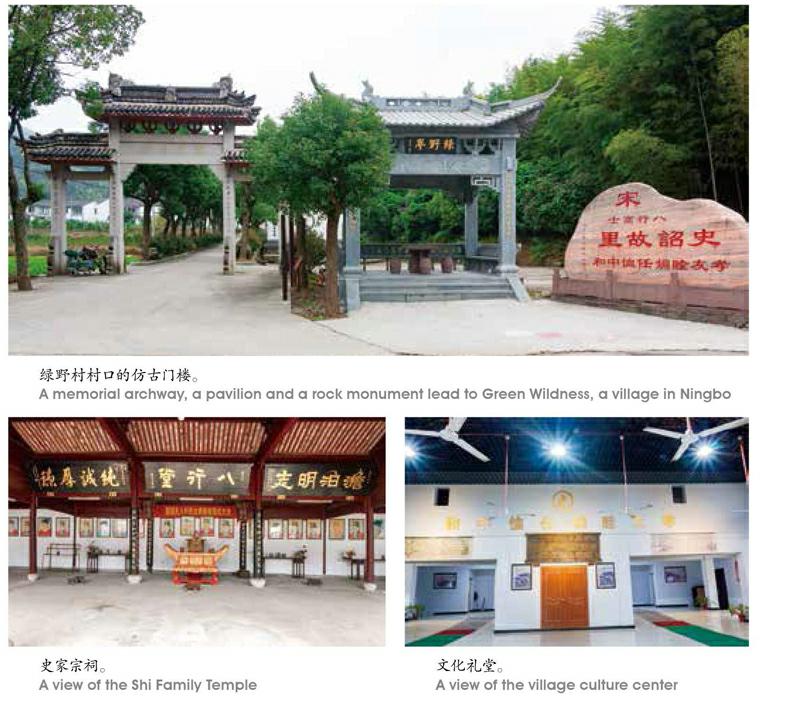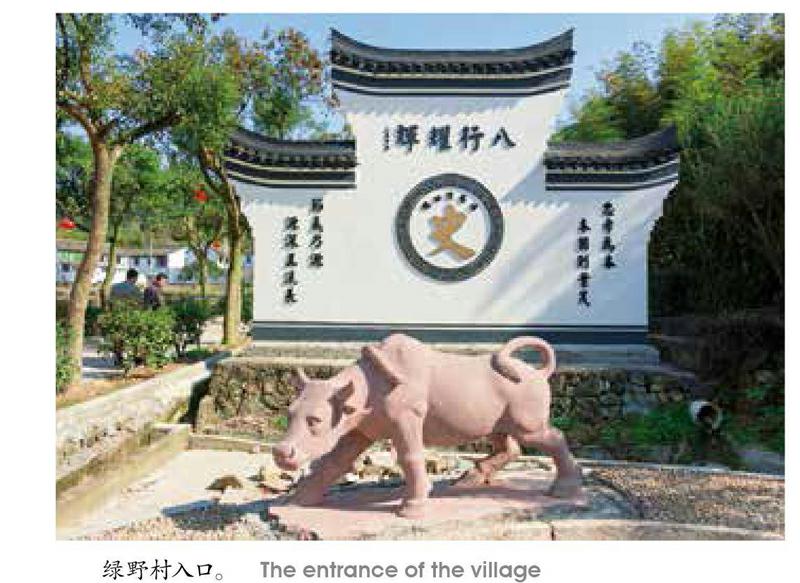东钱湖畔的桃花源:绿野
2018-01-09徐家骏
徐家骏
沿宁波鄞州区东钱湖环湖大道至下水村口,就看到一高高矗立的、造型独特的路碑,上书“十里四香”四个大字。这个“香”,其实就是“乡”的谐音。往左拐,路下小溪潺潺,前方山林叠翠之中,静卧一小山村——绿野。
千年古村绿野地处东钱湖东南山麓之中。“北有秦陵兵马俑,南有钱湖石刻群。”史诏墓道是国务院文物重点保护单位。墓道石刻像体略小,造型朴拙,反映了南宋初期和史氏发迹初期的门第状态,“北宋杨家将,南宋史氏相”,后者就是指绿野村的史氏家族。
千年古村隐高士
1700多年前,晋人陶潜写下《桃花源记》。我不是那武陵渔人,我只是一个东钱湖的游客,走在绿野古村幽深狭长的里弄里,踏石板,拂清风,闻林涛水声,听狗吠鸡鸣,我越来越觉得,绿野,是一个充满诗意的村名,和桃花源堪有一比!
绿野村又名绿野岙。这里古木参天,山灵水秀,鸟语花香。在史氏进居这个地方之前,却是人迹罕至,僻静至极。
这里说到一个历史人物——八行公史诏。史诏是遗腹子,从小就灵秀聪慧,气度不凡。寡母叶氏对他寄予厚望,虽然穷得家徒四壁,却请了名师悉心管教。成年后,他不求功名,只想守在母亲身边,以尽孝道。史诏刻苦读书,诗词文章、道德品行等各个方面,都受到了乡邻的一致赞誉。长居乡村,史诏认真细致地研究了社会现象,倡导了“孝、友、睦、姻、任、恤、中、和”八行,营建了良好的乡风,史诏本人在士大夫和乡邻们心中的威望越来越高。
宋徽宗两次颁旨召史诏入朝为官,史诏都婉言谢绝。为了不让人打扰,史诏带领全家,搬迁到离村子70里外的东钱湖畔大田山中,过上了耕读侍母的隐居生活。他们凿石造屋,开荒耕种,久而久之,形成了一个千年古村。“斗酒藏春雍,开轩有客迎。烹鲜供母箸,督濮佐春耕。园果霜前熟,山禽雨后鸣。市朝风味好,输我一般清。”在史诏一生写下的那么多的诗词里面,我最欣赏这首五律,比起晋人陶渊明的《桃花源记》来,觉得毫不逊色。
几百年来,史氏家族在这块山岙里,繁衍生息,建立起了大片人文建筑,有的至今保存完好。
源远流长血脉连
从十里四香逆青溪而上,步行半个小时,就到了绿野古村的入口。首先看到的是横陈路旁的一块巨石,上刻“宋八行高士史诏故里。孝友睦姻任恤中和”几个字,上下四行排列,红漆醒目。村口竖一座高大雄伟的仿古门楼,两层建筑,飞檐翘角,四根方形石柱,采自鄞州本地特有的梅园石。正中门额,刻“绿野古村”四个字,中间两根石柱之上刻有对联,“四代辅臣二王业绩传千古,历朝进士七二题名启后人”。读着这些文字,完全可以想象史氏家族当年的辉煌。穿过门楼,右侧筑一高墙,正中书一巨大的“史”字,配一联是,“忠孝为本本固则业茂,节义乃源源深且流长”,横批“八行耀辉”。由此可见,八行高士史诏的孝义气节,至今仍流淌在史氏后人的血液里。
绿野古村临溪而建,一片宁静祥和。
一条古巷依坡势向上蛇行,纵横数条里弄,供村民出行。出了礼堂大门,向右拐到巷口,路越来越窄了,两旁屋檐搭屋檐,如果檐下各站一个成年人,又各伸开一只手臂,恐怕都能触到对方的指尖。
脚下石板石阶,都用鄞州梅园石铺砌,石块开凿随意,走到这样的石板台阶上,古意扑面而来。因长期被踩踏,石路中间显得十分光洁,而两侧却布满绿苔,石板缝里探出野草,都散发着古村特有的气息。
村中新建文化礼堂,管理员就是史家美字辈老人,鹤发童颜,精神矍铄。我想,这是因为绿野的自然环境太好的缘故。文化礼堂宽敞明亮,展厅分上下两层,分别挂着绿野古村简介牌和先祖使用过的家具、茶具以及史简、叶太君等四明史氏先祖的画像。
在一楼展厅,墙上悬一块史料牌,《绿野岙史氏迁徙年表》。
文字很长,因是仰头看,加上灯光反射,我读得很慢,读罢长长地舒了一口气,不光是头晕颈酸,更为四明史氏的源远流长以及赫赫威名而赞叹不已。
在二楼一间小展厅里,一把巨大的石椅吸引了我的目光。据文字记载和史老先生的口头介绍,石椅原是史诏墓道石刻之一,出于文物保护目的,移至展厅。石椅背高1.1米,座高0.5米,宽0.56米。座椅及椅背披着锦帛。这张石椅民间俗称“太师椅”,是宋代不可多得的石刻椅子,对研究我们古代石椅发展史提供了极其宝贵的实物资料。
优良家风传后人
走着走着,我突生疑惑,“一门三宰相,四世二封王”;当年,史氏家族是东钱湖岸乃至整个南宋王朝的望族,凭着这样的侯门望族,怎么着也得造几座豪宅,雕梁画栋,飞檐翘角。但千年古村绿野,宅子都不大,且低矮、逼仄,都是民居民宅。想来当年的史氏家风,是何等的节俭、低调,何等的不事鋪张。
“奉母堂”是史诏在大田山的一间居室,相对其他的屋舍,应该宽敞、精致一些。当时,跟史诏一起迁居绿野就有他的四个儿子,可谓儿孙满堂,寡母叶氏吃了一辈子的苦,老了怎能不享享清福呢?但是,奉母堂究竟是哪一座,我无法辨认,村民也无法指认。岁月沧桑,或许奉母堂早已坍塌,或许本只是一间普通民房吧!八行家风,在此略见一斑。
在绿野古巷,有一个最吸人眼球的看点,那就是碎瓦墙。几乎所有的院墙,都以普通乱石砌底,上叠碎瓦。我想,风雪无情,岁月沧桑,老房总会变成废墟残垣,绿野人就利用它们来砌新墙,不但节约成本,还省去运送废料出村的麻烦。
再仔细读一读、品一品,这片片碎瓦、块块砾石,就是一本史书。
在史氏后人美露主编的《南宋四明史氏》中说:南宋史氏是一个罕见的文学世族,一门三宰相,四世两封王,五尚书,七十二进士,这在中国历史上恐怕也是绝无仅有的。当年史氏家族不仅权倾朝野,还是一个罕见的文学家族。史家历代的进士们,才气横溢,个个都有诗词佳作传世,前后数百年,卷帙浩繁,光诗集就有数百卷,其中不乏脍炙人口之作,最有品位的当然属八行公史诏了。在此,我仅抄录其中一首《立春怀忆》:endprint
寂寞荒村景,凄其今日春。趁時三盏酒,转眼一年人。
鬃短能添白,身闲亦耐贫。韶光容易老,何时逐风尘。
史氏是一个历史悠久的大家族,上可远溯自公元前的周代,后有分支。四明史氏上继溧阳族,逐渐成为宁波乃至中国历史上影响极大的一个望族。
史诏倡导“孝友睦姻任恤中和”八行,得到乡邻与士大夫的响应。宋徽宗大观二年(1108)设立“八行”取士,凡具备这八字者,身体力行,做得最好的,可免于科考直接到太学做官。史诏做得最好,皇帝两次下诏征之,史诏两次婉辞,宋徽宗佩服其人品,便亲笔御书,封史诏为“八行高士”
我们来看看何谓八行:
孝是百善之首,友似昆弟之好,睦为文明之礼,姻系民族之源,任负天下之责,恤济贫老之帛,中树正直之基,和促平安之风。
读着这些言简意赅、含义深刻的文字,我肃然起敬。“八行”,中华民族优秀道德传统的精华。八行,作为一种精神,营建了良好的社会风气,推动了当时社会的进步。日月如梭,转眼数百年过去了,但“八行”之要义,在21世纪构建和谐社会、为实现中华民族伟大复兴的“中国梦”的今天,有着不可低估的现实意义。
时值午后,阳光正烈,走在古意幽深的巷子里,一会儿就口干舌燥了。我拐进一弄口,只听到溪水淙淙,声声入耳,沿着人家院墙,踏着石阶,再转个弯,便来到了一条小溪边。蹲下身子,掬起一捧溪水,洗把脸,好清爽的感觉!我想,这千年古村里的小溪,水质肯定是没得说的,于是双手撑地,伸长脖子,像只鹅似的,嘴巴直接触到水……
我原路返回的时候,几乎一步一回头,绿林掩映之中,炊烟袅袅,路边小溪,淙淙潺潺,远远地,还依稀传来几声狗吠!好一个世外桃源啊!
A Shangri-La Village on Dongqian Lake
By Xu Jiajun
I recently visited Green Wildness, a village nestled in mountains on the southeastern side of Dongqian Lake in Ningbo. It is this village that gives Dongqian Lake a group of stone sculptures left over from the Southern Song Dynasty (1127-1279) and makes the lake famous. The village is the final sanctuary where the Shi family settled in hiding from the madding world. The standing stone sculptures of the grave of Shi Zhao (1057-1139) along the graveyard passage are now a national cultural relic.
Shi Zhaos life spanned the Northern Song Dynasty (960-1127) and the Southern Song Dynasty. He was a posthumous child. Though the family struggled in poverty, his mother managed to find him good tutors. The boy grew up to be a man of virtue and knowledge. He studied the society around him and came up with a system of ethics composed of eight principles. He was admired by local scholars and people. His reputation spread.
Emperor Huizong of the Northern Song Dynasty heard of him and wished to give him important appointments at court. Shi declined, saying he would stay with his mother and take care of her. He said on many occasions: without his mother, there would be no descendents of the Shi family. In order to avoid further intrusions, he moved his family into Datian Mountain by Dongqian Lake. It was about 35 kilometers away and the family settled down there. The family flourished. In the Southern Song Dynasty, three of Shi Zhaos descendents served as prime minister, five served as ministers, two became lords, and seventy two came out as in the highest imperial civil service examination.
Green Wildness has two landmarks in commemoration of Shi Zhao. As I approached the village I saw a monumental stone bearing engraved words indicating this is his home village and displaying the eight-word ethics system. At the entrance to the village stands a two-tier memorial archway, with four pillars and upturned eaves. On the two stone pillars is a couplet featuring the glory of the family. After ambling through the archway, I saw a huge wall on the right side presenting a Chinese character史, the surname of the family.endprint
The village is more than 850 years old. It perches on a slope along a stream. It oozes serenity. I followed an ancient lane snaking through the village, crisscrossed by a labyrinth of lanes paved with flat stones. Due to the footstep wear and tear of the past centuries, the flat stones look shiny, but the edges of the stones are stained with green algae and dotted with weeds peeking out of the crevices.
The villages cultural center displays a delightful contrast of the old and the new: it is a brand-new two-story structure and it displays the ancient story of the Shi family. The curator is a silver-haired hale and hearty old man. Naturally, he was a Shi descendent. On a wall of the exhibition hall on the ground floor is a long textual message illustrating how all the key family members of the past centuries migrated and where they settled down. I spent a long time going through the text. The chronicle indicates how amazing the family was.
I ascended to the second floor. A stone armchair in a small room attracted my attention. The curator told me that it came from the graveyard passage. It was one of the stone sculptures created in the Southern Song Dynasty. The armchairs back is 1.1 meters tall whereas the seat is 0.5 meter tall and 0.56 meter wide. It was removed from the venue for the purpose of protection. This armchair is rare and precious simply because it is a stone armchair and it dates back to the Southern Song Dynasty.
While strolling through the village, I noticed something unusual. The clan was famous throughout the Southern Song Dynasty, but the village does not look stately. The village boasts no grand houses and no houses are ornately decorated. The ancient houses are all ordinary. I asked some villagers and they didnt know where Shi Zhao once lived. Then I made a guess that the family kept a low profile and led a frugal life.
Another unusual sight in the village is the yard walls. They are made of irregular rocks topped with broken roof tiles. They are apparently recycled building materials. Houses come and go, but building materials stay. It is a good idea to hold.endprint
